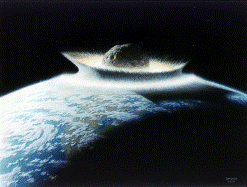
Geoscientist Online 18 June 2007
Striking new evidence casts grave doubt on the Chicxulub Crater's popular status as the dinosaurs' nemesis, writes Dwain Eldred
Newly published research strongly suggests that the Chicxulub Crater is too old to be the remains of an end-Cretaceous impact that destroyed the dinosaurs and deposited a worldwide iridium-rich horizon.
Studies of rocks from outcrops along the Brazos River and Cottonmouth Creek (Falls County, Texas) together with a new core (Mullinax-1, paid for by the US National Science Foundation) have looked in fine detail at the stratigraphy, sedimentology, mineralogy and geochemistry of a sequence stretching from c. 66.4Ma (more than a million years before the Chicxulub impact at 65.3Ma) to c. 64.7Ma, about 300,000 years after the iridium anomaly that marks the K-T boundary at c. 65Ma. All the results suggest that the Chicxulub impact predates the end of the Maastrichtian probably by c. 300,000 years and far from being the dinosaur-killer, had no effect on living things at all.
Part of the problem in treating fine resolution stratigraphy close to a major impact is the complexity of sequences and the potential for disruption by the massive energy of the bolide. These study areas by contrast expose rocks of the right age that were deposited c.1700km away from the impact, and provide an undisturbed record. The rocks are also relatively undeformed tectonically, and boasted excellently preserved fossils, as well as a sandstone complex believed by many to represent “tsunami deposits”.
The researchers, led by Prof. Gerta Keller (Princeton University), had three aims – to determine the age of the impact exactly, search for an original, un-reworked layer containing glass bead (spherule) ejecta, and to see how the impact affected all the organisms that lived through the experience. An impact widely supposed to have caused worldwide extinctions should, after all, have had noticeable effects.
The three cores drilled and two successions logged in situ were sampled at 5-10cm intervals (1-2cm intervals across critical parts of the section) and samples distributed to an international team of palaeontologists, sedimentologists, mineralogists and geochemists, who were asked to perform detailed biostratigraphy, quantify individual species abundance changes of planktic and benthic foraminifera, calcareous nannofossils, pollen and spores, evaluate trace element variations, study stable isotopes of bulk rock, organic carbon, and study palaeomagnetism. The sediments were tested for bulk rock and clay mineralogy, total organic carbon and grain size. Glass spherules were geochemically analysed using raster electron microscopy, backscatter electron imaging, and electron microprobe analysis.
The project identified the impact spherule layer in a 3cm-thick yellow clay containing relict glass spherules. The clay’s geochemistry matched that of altered impact spherules precisely, which is highly suggestive of a common impact origin. It lay some distance below the sandstone unit commonly ascribed to impact-generated tsunamis, which itself was some way below the K-T boundary.
The sequence of events revealed the following depositional history along the Brazos River of Texas. Before the impact, quiet, shallow marine sedimentation was taking place at depths of 80-100m in a warm climate. Mudstones and claystones with burrows bore abundant evidence of a rich diversity of life. Then the Chicxulub impact hit Yucatan, Mexico.
Glass bead game
Within hours or days of the impact 1700km away, a thin layer of impact melt glass spherules – rained down over an area stretching from New Jersey to Brazil. Tsunamis probably swept outwards from the impact site, but their deposits were seemingly redistributed by prevailing current regimes, because there is no evidence of any significant disturbance above or below the spherule layer either in Brazos, or in NE Mexico.
After the impact, everything went back to normal; but for the next 200k years sea level was falling – by about 60m in all, and perhaps reaching a low of 20-30m in west Texas. Nearshore areas were exposed to erosion. In this shallow environment currents scoured small canyons and valleys, into which eroded sediments from nearshore areas were dumped. The first sediments to arrive included many rip-up clasts of already lithified sediments that themselves contained impact spherules. Some clasts displayed desiccation cracks in which spherules had become trapped, showing that the impact layer had been exposed to erosion. Above the basal conglomerate several fining-upward units follow on, containing shell hash, spherules, smaller clasts and nodules of glauconite - probably representing seasonal storm deposits.
Towards the top of the sandstone unit, conditions began to deepen once again, and layers truncating burrows show the repeated recolonisation of the sea bed over an extended period. At the top of the unit normal marine desposition returned with the deposition of an upward fining calcareous silty mudstone that grades into a dark organic-rich claystone. The water appears to have been poorly oxygenated, demonstrated by framboidal pyrite and a low diversity micro fossil assemblage that prevailed until the K-T boundary itself. The sandstone unit, in other words postdated the Chicxulub impact by a long time and is not a tsunami deposit.
Although the Chicxulub impact is widely believed to be the K-T killer, not a single species becomes extinct across the impact ejecta layer sequence. It is looking likely that the Chicxulub crater impact had no effect on life on Earth whatsoever.
Keller says: “Conventional wisdom holds that any such large impact leaving a 175km-diameter crater would cause major mass extinctions. But this hypothesis is based solely upon the assumption that Chicxulub was the K-T killer. None of the other major mass extinctions in Earth history is associated with major impacts. This hypothesis has no empirical support and must be considered false – at least with respect to Chicxulub.”
References
- Keller, G et al., 2007a Chicxulub impact predates K-T boundary: New evidence from Brazos, Texas. Earth & Planetary Science Letters 255, 339-356
- Keller, G 2007b The Chicxulub Impact and K-T mass extinction in Texas. Bulletin of the South Texas Geological Society XLVII, no 9 pp1-26.
“The Great Chicxulub Debate”, a mediated online discussion between Gerta Keller and her opponents, took place on www.geolsoc.org.uk in 2003.